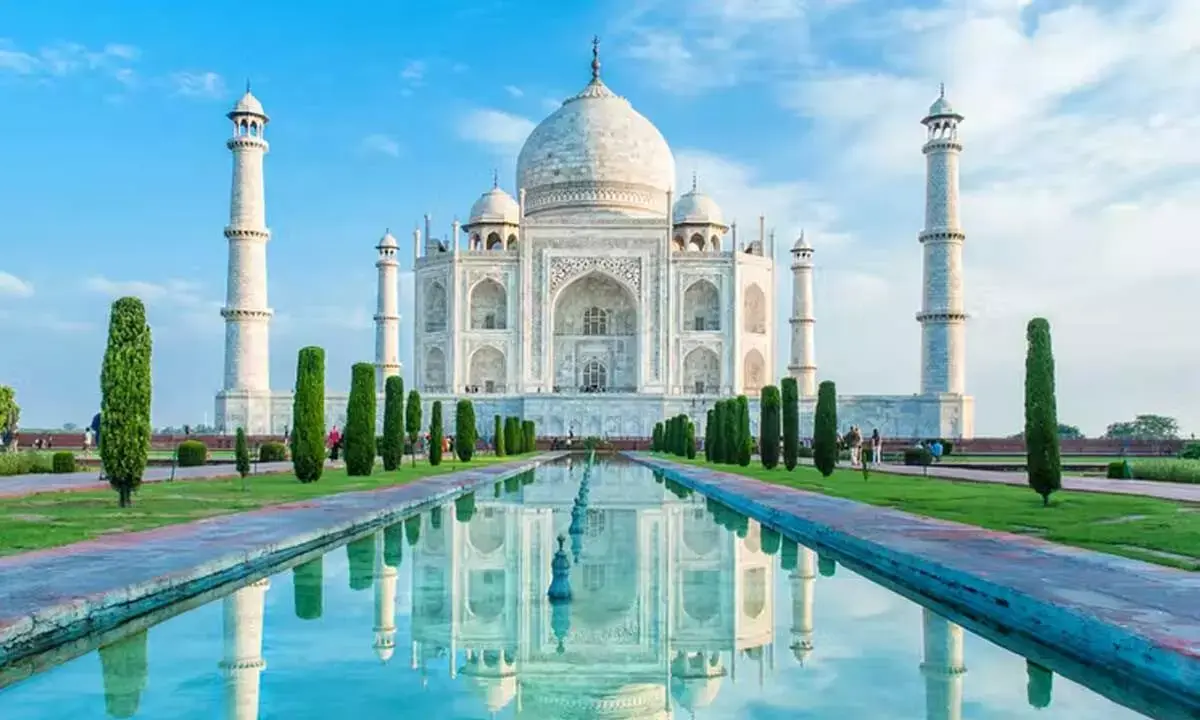
Agra
The magical appeal of Taj Mahal calls people from far lands to this otherwise busy city. In addition to the Taj Mahal, Agra Fort and Fatehpur Sikri are the other UNESCO World Heritage sites. Agra has plenty of other building complexes and tombs that mark the wonderful days of glory from its past. Being the Mughal capital from 1525 to 1700, it thrived profusely on trade and tourism – something it is still getting in bountiful.
If you are planning to visit Agra in the near future, here are some of the places you must visit:
Taj Mahal: The mighty epitome of love, Taj Mahal looks glorious all year round. Built in 1648, it took 20 years and 20,000 men to complete the mausoleum. It is built entirely of white marble, symbolizing the love for Mumtaz by Jahangir. In the words of a great English Poet, Taj Mahal is not a piece of architecture, but a presentation of passion that an emperor can bring to stones to fulfill his desire of love. It is a celebration of the eternal and most beloved bond that a man and a woman can share. The complex has several other buildings and with well-maintained lawns and clear water flowing within the reflecting pools, seeing it is mesmerizing. There are many trees around and seeing Taj against their background makes up for some awe-inspiring photography shots. Taj Mahal opens from 6:00 am to 6:30 pm. Entry fee is ?20 for Indians and ?750 for foreigners. One of the best times to see Taj is on the nights of the full moon, when the marble of the entire complex reflects in the moonlight. The ticket for full moon nights is ?1,000 and all visitors are allowed only for 20 minutes. On weekends, a lot of people visit the Taj and overshadow its grandeur.
Agra Fort: Most who come to Agra to see Taj Mahal make the mistake of ignoring the city fort. It is, in reality, on par with the Taj and a fine representation of the Mughal Empire. Akbar began its construction in 1565 and made it into a fort. Shah Jahan changed it into a palace, and later Aurangzeb converted it into a prison to keep his father. The design and layout of Agra Fort resemble an ear, and deliberate confusion was created in the hallways to act as the first line of defense in case enemy soldiers ever came inside it. The fort opens from sunrise to sunset. Entry fee is ?10 for Indians and ?250 for foreigners.
Mehtab Bagh: Mehtab Bagh is visible from the backside of Taj, right across in the direction of the Yamuna. Legend says that after Shah Jahan completed the mausoleum of white marble (Taj Mahal), he wanted to build a replica in black marble. Though the foundation work on Mehtab Bagh started, he couldn’t complete it as his own son imprisoned him soon after. The place is just a sort of a beautiful park, maintained nicely by the authorities.
Fatehpur Sikri: Another great piece of architecture, Akbar ordered its construction during the second half of the sixteenth century. It was completed in just a decade, but unfortunately, the scarcity of drinkable water forced the Mughals to shift their base to Agra. Among other famous chambers and interesting places including the Dargah of Salim Chishti, it also houses the Buland Darwaza (Victory Gate), which was built to commemorate Akbar's victory in Gujarat. At 54 meters, the door is the tallest of its kind in Asia.
Sheesh Mahal: Named so because of the extensive use of Syrian mirrors on the ceilings and the walls, Sheesh Mahal is located below the Diwan-i-Khas Hall of the Agra Fort. It is an example of splendid Mughal architecture and was made as an imperial bath. The palace is intentionally made dark inside to necessitate the use of artificial light. It gives a very beautiful and dramatic effect when illuminated.
Mariam-Zamani Tomb: Tomb of the Rajput queen of Emperor Akbar and the daughter of Raja Bharmal Kachhwaha of Amer. She was given this name on the birth of Salim by Akbar at Fatehpur Sikri. On her death, her son made an elegant tomb, near the tomb of Akbar. The tomb is made within the compound of the Christian Missionary Society and resembles its architecture.
Tomb of Akbar: Another Mughal masterpiece, the tomb was made by Akbar’s son Jahangir in loving memory of his father. It covers an area of almost 20 acres and was completed in 1613. Adorned with colorful carvings on the roof, it is well-ventilated and has over 23 chambers. The actual tomb is located right beneath the middlemost room and requires to be reached from stairs under the complex.
Guru Ka Tal: With a strong aura of peace and spirituality, Guru Ka Tal opens its arms to people from every religion. It was made to honor the ninth guru of Sikhs, Shri Guru Teg Bahadur Singh, and was completed in the early 17th century. The gurudwara is made at the place where Guru Teg Bahadur Singh laid down his weapons to surrender to Aurangzeb. The Tal initially had twelve towers, but now only eight of them remain.
Ram Bagh: One of the oldest Mughal Gardens in India, Ram Bagh is marked as a must-see place to visit in Agra for historians. The garden is next to a transport market and sometimes becomes a collection ground for all the waste and disposable items. However, visiting it during early morning might save you from seeing trash that gets cleaned up every night.
Other than these, Agra also has Moti Masjid, Jama Masjid (Fatehpur Sikri), Panch Mahal, and the great Mahakambleshwar Temple that you can quickly visit and complete within an hour each.
Interested in visiting Agra? Click Here And Plan Your Vacation
